+ Open data
Open data
- Basic information
Basic information
| Entry |  | |||||||||
|---|---|---|---|---|---|---|---|---|---|---|
| Title | Consensus map of the CD163/HpSPHb complex (Map L) | |||||||||
 Map data Map data | ||||||||||
 Sample Sample |
| |||||||||
 Keywords Keywords | CD163 / M130 / Scavenger receptor / Haptoglobin / Hemoglobin / Hb / Hp / HpSP / HpHb / hemolysis / ENDOCYTOSIS | |||||||||
| Function / homology |  Function and homology information Function and homology informationnegative regulation of hydrogen peroxide catabolic process / zymogen activation / CD163 mediating an anti-inflammatory response / scavenger receptor activity / nitric oxide transport / hemoglobin alpha binding / cellular oxidant detoxification / hemoglobin binding / haptoglobin-hemoglobin complex / renal absorption ...negative regulation of hydrogen peroxide catabolic process / zymogen activation / CD163 mediating an anti-inflammatory response / scavenger receptor activity / nitric oxide transport / hemoglobin alpha binding / cellular oxidant detoxification / hemoglobin binding / haptoglobin-hemoglobin complex / renal absorption / antioxidant activity / hemoglobin complex / oxygen transport / immune system process / Scavenging of heme from plasma / endocytic vesicle lumen / blood vessel diameter maintenance / acute-phase response / hydrogen peroxide catabolic process / oxygen carrier activity / carbon dioxide transport / response to hydrogen peroxide / Heme signaling / Erythrocytes take up oxygen and release carbon dioxide / Erythrocytes take up carbon dioxide and release oxygen / Late endosomal microautophagy / defense response / Cytoprotection by HMOX1 / oxygen binding / regulation of blood pressure / platelet aggregation / specific granule lumen / Chaperone Mediated Autophagy / positive regulation of nitric oxide biosynthetic process / endocytic vesicle membrane / tertiary granule lumen / Factors involved in megakaryocyte development and platelet production / scaffold protein binding / blood microparticle / ficolin-1-rich granule lumen / defense response to bacterium / iron ion binding / inflammatory response / external side of plasma membrane / serine-type endopeptidase activity / heme binding / Neutrophil degranulation / extracellular space / extracellular exosome / extracellular region / metal ion binding / membrane / plasma membrane / cytosol Similarity search - Function | |||||||||
| Biological species |  Homo sapiens (human) Homo sapiens (human) | |||||||||
| Method | single particle reconstruction / cryo EM / Resolution: 4.0 Å | |||||||||
 Authors Authors | Huang C-S / White JBR / Degtjarik O | |||||||||
| Funding support |  United Kingdom, 2 items United Kingdom, 2 items
| |||||||||
 Citation Citation |  Journal: PLoS Biol / Year: 2025 Journal: PLoS Biol / Year: 2025Title: Structural elucidation of the haptoglobin-hemoglobin clearance mechanism by macrophage scavenger receptor CD163. Authors: Ching-Shin Huang / Hui Wang / Joshua B R White / Oksana Degtjarik / Cindy Huynh / Kristoffer Brannstrom / Mark T Horn / Stephen P Muench / William S Somers / Javier Chaparro-Riggers / Laura ...Authors: Ching-Shin Huang / Hui Wang / Joshua B R White / Oksana Degtjarik / Cindy Huynh / Kristoffer Brannstrom / Mark T Horn / Stephen P Muench / William S Somers / Javier Chaparro-Riggers / Laura Lin / Lidia Mosyak /   Abstract: Intravascular hemolysis releases hemoglobin into the bloodstream, which can damage vascular and renal tissues due to its oxidative nature. Circulating haptoglobin acts as a primary defense by binding ...Intravascular hemolysis releases hemoglobin into the bloodstream, which can damage vascular and renal tissues due to its oxidative nature. Circulating haptoglobin acts as a primary defense by binding to free hemoglobin, forming a haptoglobin-hemoglobin (HpHb) complex that is then recognized and cleared by the CD163 scavenger receptor on macrophages. While the function and structure of HpHb complex are mostly well-defined, the molecular mechanism underlying its interaction with CD163 remains unclear. Here we report the cryo-electron microscopy structures of human CD163 in its unliganded state and in its complex with HpHb. These structures reveal that CD163 functions as a trimer, forming a composite binding site at its center for one protomer of the dimeric HpHb, resulting in a 3:1 binding stoichiometry. In the unliganded state, CD163 can also form a trimer, but in an autoinhibitory configuration that occludes the ligand binding site. Widespread electrostatic interactions mediated by calcium ions are pivotal in both pre-ligand and ligand-bound receptor assemblies. This calcium-dependent mechanism enables CD163/HpHb complexes to assemble and, once internalized, disassemble into individual components upon reaching the endosome, where low calcium and lower pH conditions prevail. Collectively, this study elucidates the molecular mechanism by which CD163-mediated endocytosis efficiently clears different isoforms of HpHb. | |||||||||
| History |
|
- Structure visualization
Structure visualization
| Supplemental images |
|---|
- Downloads & links
Downloads & links
-EMDB archive
| Map data |  emd_49219.map.gz emd_49219.map.gz | 118.1 MB |  EMDB map data format EMDB map data format | |
|---|---|---|---|---|
| Header (meta data) |  emd-49219-v30.xml emd-49219-v30.xml emd-49219.xml emd-49219.xml | 23.7 KB 23.7 KB | Display Display |  EMDB header EMDB header |
| FSC (resolution estimation) |  emd_49219_fsc.xml emd_49219_fsc.xml | 10.6 KB | Display |  FSC data file FSC data file |
| Images |  emd_49219.png emd_49219.png | 104.3 KB | ||
| Masks |  emd_49219_msk_1.map emd_49219_msk_1.map | 125 MB |  Mask map Mask map | |
| Filedesc metadata |  emd-49219.cif.gz emd-49219.cif.gz | 6.3 KB | ||
| Others |  emd_49219_half_map_1.map.gz emd_49219_half_map_1.map.gz emd_49219_half_map_2.map.gz emd_49219_half_map_2.map.gz | 116 MB 116 MB | ||
| Archive directory |  http://ftp.pdbj.org/pub/emdb/structures/EMD-49219 http://ftp.pdbj.org/pub/emdb/structures/EMD-49219 ftp://ftp.pdbj.org/pub/emdb/structures/EMD-49219 ftp://ftp.pdbj.org/pub/emdb/structures/EMD-49219 | HTTPS FTP |
-Validation report
| Summary document |  emd_49219_validation.pdf.gz emd_49219_validation.pdf.gz | 966.4 KB | Display |  EMDB validaton report EMDB validaton report |
|---|---|---|---|---|
| Full document |  emd_49219_full_validation.pdf.gz emd_49219_full_validation.pdf.gz | 966 KB | Display | |
| Data in XML |  emd_49219_validation.xml.gz emd_49219_validation.xml.gz | 19.2 KB | Display | |
| Data in CIF |  emd_49219_validation.cif.gz emd_49219_validation.cif.gz | 25 KB | Display | |
| Arichive directory |  https://ftp.pdbj.org/pub/emdb/validation_reports/EMD-49219 https://ftp.pdbj.org/pub/emdb/validation_reports/EMD-49219 ftp://ftp.pdbj.org/pub/emdb/validation_reports/EMD-49219 ftp://ftp.pdbj.org/pub/emdb/validation_reports/EMD-49219 | HTTPS FTP |
-Related structure data
| Related structure data |  9nb5C  9nb6C  9nb8C C: citing same article ( |
|---|---|
| Similar structure data | Similarity search - Function & homology  F&H Search F&H Search |
- Links
Links
| EMDB pages |  EMDB (EBI/PDBe) / EMDB (EBI/PDBe) /  EMDataResource EMDataResource |
|---|---|
| Related items in Molecule of the Month |
- Map
Map
| File |  Download / File: emd_49219.map.gz / Format: CCP4 / Size: 125 MB / Type: IMAGE STORED AS FLOATING POINT NUMBER (4 BYTES) Download / File: emd_49219.map.gz / Format: CCP4 / Size: 125 MB / Type: IMAGE STORED AS FLOATING POINT NUMBER (4 BYTES) | ||||||||||||||||||||||||||||||||||||
|---|---|---|---|---|---|---|---|---|---|---|---|---|---|---|---|---|---|---|---|---|---|---|---|---|---|---|---|---|---|---|---|---|---|---|---|---|---|
| Projections & slices | Image control
Images are generated by Spider. | ||||||||||||||||||||||||||||||||||||
| Voxel size | X=Y=Z: 1.11 Å | ||||||||||||||||||||||||||||||||||||
| Density |
| ||||||||||||||||||||||||||||||||||||
| Symmetry | Space group: 1 | ||||||||||||||||||||||||||||||||||||
| Details | EMDB XML:
|
-Supplemental data
-Mask #1
| File |  emd_49219_msk_1.map emd_49219_msk_1.map | ||||||||||||
|---|---|---|---|---|---|---|---|---|---|---|---|---|---|
| Projections & Slices |
| ||||||||||||
| Density Histograms |
-Half map: #2
| File | emd_49219_half_map_1.map | ||||||||||||
|---|---|---|---|---|---|---|---|---|---|---|---|---|---|
| Projections & Slices |
| ||||||||||||
| Density Histograms |
-Half map: #1
| File | emd_49219_half_map_2.map | ||||||||||||
|---|---|---|---|---|---|---|---|---|---|---|---|---|---|
| Projections & Slices |
| ||||||||||||
| Density Histograms |
- Sample components
Sample components
-Entire : CD163/HpSPHb complex
| Entire | Name: CD163/HpSPHb complex |
|---|---|
| Components |
|
-Supramolecule #1: CD163/HpSPHb complex
| Supramolecule | Name: CD163/HpSPHb complex / type: complex / ID: 1 / Parent: 0 / Macromolecule list: all |
|---|---|
| Source (natural) | Organism:  Homo sapiens (human) Homo sapiens (human) |
| Molecular weight | Theoretical: 450 KDa |
-Macromolecule #1: CD163
| Macromolecule | Name: CD163 / type: protein_or_peptide / ID: 1 / Enantiomer: LEVO |
|---|---|
| Source (natural) | Organism:  Homo sapiens (human) Homo sapiens (human) |
| Recombinant expression | Organism:  Homo sapiens (human) Homo sapiens (human) |
| Sequence | String: SSLGGTDKEL RLVDGENKCS GRVEVKVQEE WGTVCNNGWS MEAVSVICNQ LGCPTAIKAP GWANSSAGSG RIWMDHVSCR GNESALWDCK HDGWGKHSNC THQQDAGVTC SDGSNLEMRL TRGGNMCSGR IEIKFQGRWG TVCDDNFNID HASVICRQLE CGSAVSFSGS ...String: SSLGGTDKEL RLVDGENKCS GRVEVKVQEE WGTVCNNGWS MEAVSVICNQ LGCPTAIKAP GWANSSAGSG RIWMDHVSCR GNESALWDCK HDGWGKHSNC THQQDAGVTC SDGSNLEMRL TRGGNMCSGR IEIKFQGRWG TVCDDNFNID HASVICRQLE CGSAVSFSGS SNFGEGSGPI WFDDLICNGN ESALWNCKHQ GWGKHNCDHA EDAGVICSKG ADLSLRLVDG VTECSGRLEV RFQGEWGTIC DDGWDSYDAA VACKQLGCPT AVTAIGRVNA SKGFGHIWLD SVSCQGHEPA IWQCKHHEWG KHYCNHNEDA GVTCSDGSDL ELRLRGGGSR CAGTVEVEIQ RLLGKVCDRG WGLKEADVVC RQLGCGSALK TSYQVYSKIQ ATNTWLFLSS CNGNETSLWD CKNWQWGGLT CDHYEEAKIT CSAHREPRLV GGDIPCSGRV EVKHGDTWGS ICDSDFSLEA ASVLCRELQC GTVVSILGGA HFGEGNGQIW AEEFQCEGHE SHLSLCPVAP RPEGTCSHSR DVGVVCSRYT EIRLVNGKTP CEGRVELKTL GAWGSLCNSH WDIEDAHVLC QQLKCGVALS TPGGARFGKG NGQIWRHMFH CTGTEQHMGD CPVTALGASL CPSEQVASVI CSGNQSQTLS SCNSSSLGPT RPTIPEESAV ACIESGQLRL VNGGGRCAGR VEIYHEGSWG TICDDSWDLS DAHVVCRQLG CGEAINATGS AHFGEGTGPI WLDEMKCNGK ESRIWQCHSH GWGQQNCRHK EDAGVICSEF MSLRLTSEAS REACAGRLEV FYNGAWGTVG KSSMSETTVG VVCRQLGCAD KGKINPASLD KAMSIPMWVD NVQCPKGPDT LWQCPSSPWE KRLASPSEET WITCDNKIRL QEGPTSCSGR VEIWHGGSWG TVCDDSWDLD DAQVVCQQLG CGPALKAFKE AEFGQGTGPI WLNEVKCKGN ESSLWDCPAR RWGHSECGHK EDAAVNCTDI SVQKTPQKAT TGRSHHHHHH HH UniProtKB: Scavenger receptor cysteine-rich type 1 protein M130 |
-Macromolecule #2: CD163
| Macromolecule | Name: CD163 / type: protein_or_peptide / ID: 2 / Enantiomer: LEVO |
|---|---|
| Source (natural) | Organism:  Homo sapiens (human) Homo sapiens (human) |
| Recombinant expression | Organism:  Homo sapiens (human) Homo sapiens (human) |
| Sequence | String: SSLGGTDKEL RLVDGENKCS GRVEVKVQEE WGTVCNNGWS MEAVSVICNQ LGCPTAIKAP GWANSSAGSG RIWMDHVSCR GNESALWDCK HDGWGKHSNC THQQDAGVTC SDGSNLEMRL TRGGNMCSGR IEIKFQGRWG TVCDDNFNID HASVICRQLE CGSAVSFSGS ...String: SSLGGTDKEL RLVDGENKCS GRVEVKVQEE WGTVCNNGWS MEAVSVICNQ LGCPTAIKAP GWANSSAGSG RIWMDHVSCR GNESALWDCK HDGWGKHSNC THQQDAGVTC SDGSNLEMRL TRGGNMCSGR IEIKFQGRWG TVCDDNFNID HASVICRQLE CGSAVSFSGS SNFGEGSGPI WFDDLICNGN ESALWNCKHQ GWGKHNCDHA EDAGVICSKG ADLSLRLVDG VTECSGRLEV RFQGEWGTIC DDGWDSYDAA VACKQLGCPT AVTAIGRVNA SKGFGHIWLD SVSCQGHEPA IWQCKHHEWG KHYCNHNEDA GVTCSDGSDL ELRLRGGGSR CAGTVEVEIQ RLLGKVCDRG WGLKEADVVC RQLGCGSALK TSYQVYSKIQ ATNTWLFLSS CNGNETSLWD CKNWQWGGLT CDHYEEAKIT CSAHREPRLV GGDIPCSGRV EVKHGDTWGS ICDSDFSLEA ASVLCRELQC GTVVSILGGA HFGEGNGQIW AEEFQCEGHE SHLSLCPVAP RPEGTCSHSR DVGVVCSRYT EIRLVNGKTP CEGRVELKTL GAWGSLCNSH WDIEDAHVLC QQLKCGVALS TPGGARFGKG NGQIWRHMFH CTGTEQHMGD CPVTALGASL CPSEQVASVI CSGNQSQTLS SCNSSSLGPT RPTIPEESAV ACIESGQLRL VNGGGRCAGR VEIYHEGSWG TICDDSWDLS DAHVVCRQLG CGEAINATGS AHFGEGTGPI WLDEMKCNGK ESRIWQCHSH GWGQQNCRHK EDAGVICSEF MSLRLTSEAS REACAGRLEV FYNGAWGTVG KSSMSETTVG VVCRQLGCAD KGKINPASLD KAMSIPMWVD NVQCPKGPDT LWQCPSSPWE KRLASPSEET WITCDNKIRL QEGPTSCSGR VEIWHGGSWG TVCDDSWDLD DAQVVCQQLG CGPALKAFKE AEFGQGTGPI WLNEVKCKGN ESSLWDCPAR RWGHSECGHK EDAAVNCTDI SVQKTPQKAT TGRSHHHHHH HH UniProtKB: Scavenger receptor cysteine-rich type 1 protein M130 |
-Macromolecule #3: CD163
| Macromolecule | Name: CD163 / type: protein_or_peptide / ID: 3 / Enantiomer: LEVO |
|---|---|
| Source (natural) | Organism:  Homo sapiens (human) Homo sapiens (human) |
| Recombinant expression | Organism:  Homo sapiens (human) Homo sapiens (human) |
| Sequence | String: SSLGGTDKEL RLVDGENKCS GRVEVKVQEE WGTVCNNGWS MEAVSVICNQ LGCPTAIKAP GWANSSAGSG RIWMDHVSCR GNESALWDCK HDGWGKHSNC THQQDAGVTC SDGSNLEMRL TRGGNMCSGR IEIKFQGRWG TVCDDNFNID HASVICRQLE CGSAVSFSGS ...String: SSLGGTDKEL RLVDGENKCS GRVEVKVQEE WGTVCNNGWS MEAVSVICNQ LGCPTAIKAP GWANSSAGSG RIWMDHVSCR GNESALWDCK HDGWGKHSNC THQQDAGVTC SDGSNLEMRL TRGGNMCSGR IEIKFQGRWG TVCDDNFNID HASVICRQLE CGSAVSFSGS SNFGEGSGPI WFDDLICNGN ESALWNCKHQ GWGKHNCDHA EDAGVICSKG ADLSLRLVDG VTECSGRLEV RFQGEWGTIC DDGWDSYDAA VACKQLGCPT AVTAIGRVNA SKGFGHIWLD SVSCQGHEPA IWQCKHHEWG KHYCNHNEDA GVTCSDGSDL ELRLRGGGSR CAGTVEVEIQ RLLGKVCDRG WGLKEADVVC RQLGCGSALK TSYQVYSKIQ ATNTWLFLSS CNGNETSLWD CKNWQWGGLT CDHYEEAKIT CSAHREPRLV GGDIPCSGRV EVKHGDTWGS ICDSDFSLEA ASVLCRELQC GTVVSILGGA HFGEGNGQIW AEEFQCEGHE SHLSLCPVAP RPEGTCSHSR DVGVVCSRYT EIRLVNGKTP CEGRVELKTL GAWGSLCNSH WDIEDAHVLC QQLKCGVALS TPGGARFGKG NGQIWRHMFH CTGTEQHMGD CPVTALGASL CPSEQVASVI CSGNQSQTLS SCNSSSLGPT RPTIPEESAV ACIESGQLRL VNGGGRCAGR VEIYHEGSWG TICDDSWDLS DAHVVCRQLG CGEAINATGS AHFGEGTGPI WLDEMKCNGK ESRIWQCHSH GWGQQNCRHK EDAGVICSEF MSLRLTSEAS REACAGRLEV FYNGAWGTVG KSSMSETTVG VVCRQLGCAD KGKINPASLD KAMSIPMWVD NVQCPKGPDT LWQCPSSPWE KRLASPSEET WITCDNKIRL QEGPTSCSGR VEIWHGGSWG TVCDDSWDLD DAQVVCQQLG CGPALKAFKE AEFGQGTGPI WLNEVKCKGN ESSLWDCPAR RWGHSECGHK EDAAVNCTDI SVQKTPQKAT TGRSHHHHHH HH UniProtKB: Scavenger receptor cysteine-rich type 1 protein M130 |
-Macromolecule #4: HBA1
| Macromolecule | Name: HBA1 / type: protein_or_peptide / ID: 4 / Enantiomer: LEVO |
|---|---|
| Source (natural) | Organism:  Homo sapiens (human) Homo sapiens (human) |
| Sequence | String: MVLSPADKTN VKAAWGKVGA HAGEYGAEAL ERMFLSFPTT KTYFPHFDLS HGSAQVKGHG KKVADALTNA VAHVDDMPNA LSALSDLHAH KLRVDPVNFK LLSHCLLVTL AAHLPAEFTP AVHASLDKFL ASVSTVLTSK YR UniProtKB: Hemoglobin subunit alpha |
-Macromolecule #5: HBB
| Macromolecule | Name: HBB / type: protein_or_peptide / ID: 5 / Enantiomer: LEVO |
|---|---|
| Source (natural) | Organism:  Homo sapiens (human) Homo sapiens (human) |
| Sequence | String: MVHLTPEEKS AVTALWGKVN VDEVGGEALG RLLVVYPWTQ RFFESFGDLS TPDAVMGNPK VKAHGKKVLG AFSDGLAHLD NLKGTFATLS ELHCDKLHVD PENFRLLGNV LVCVLAHHFG KEFTPPVQAA YQKVVAGVAN ALAHKYH UniProtKB: Hemoglobin subunit beta |
-Macromolecule #6: HpSP
| Macromolecule | Name: HpSP / type: protein_or_peptide / ID: 6 / Enantiomer: LEVO |
|---|---|
| Source (natural) | Organism:  Homo sapiens (human) Homo sapiens (human) |
| Sequence | String: HHHHHHAVCG KPKNPANPVQ RILGGHLDAK GSFPWQAKMV SHHNLTTGAT LINEQWLLTT AKNLFLNHSE NATAKDIAPT LTLYVGKKQL VEIEKVVLHP NYSQVDIGLI KLKQKVSVNE RVMPICLPSK DYAEVGRVGY VSGWGRNANF KFTDHLKYVM LPVADQDQCI ...String: HHHHHHAVCG KPKNPANPVQ RILGGHLDAK GSFPWQAKMV SHHNLTTGAT LINEQWLLTT AKNLFLNHSE NATAKDIAPT LTLYVGKKQL VEIEKVVLHP NYSQVDIGLI KLKQKVSVNE RVMPICLPSK DYAEVGRVGY VSGWGRNANF KFTDHLKYVM LPVADQDQCI RHYEGSTVPE KKTPKSPVGV QPILNEHTFC AGMSKYQEDT CYGDAGSAFA VHDLEEDTWY ATGILSFDKS CAVAEYGVYV KVTSIQDWVQ KTIAEN UniProtKB: Haptoglobin |
-Experimental details
-Structure determination
| Method | cryo EM |
|---|---|
 Processing Processing | single particle reconstruction |
| Aggregation state | particle |
- Sample preparation
Sample preparation
| Concentration | 0.1 mg/mL |
|---|---|
| Buffer | pH: 7.5 |
| Grid | Model: Quantifoil R1.2/1.3 / Material: COPPER / Mesh: 300 / Pretreatment - Type: GLOW DISCHARGE |
| Vitrification | Cryogen name: ETHANE / Chamber humidity: 100 % / Chamber temperature: 277 K / Instrument: FEI VITROBOT MARK IV |
- Electron microscopy
Electron microscopy
| Microscope | TFS KRIOS |
|---|---|
| Specialist optics | Energy filter - Name: TFS Selectris / Energy filter - Slit width: 10 eV |
| Image recording | Film or detector model: FEI FALCON IV (4k x 4k) / Average electron dose: 40.68 e/Å2 |
| Electron beam | Acceleration voltage: 300 kV / Electron source:  FIELD EMISSION GUN FIELD EMISSION GUN |
| Electron optics | Illumination mode: FLOOD BEAM / Imaging mode: BRIGHT FIELD / Nominal defocus max: 2.5 µm / Nominal defocus min: 1.0 µm |
| Experimental equipment |  Model: Titan Krios / Image courtesy: FEI Company |
 Movie
Movie Controller
Controller

















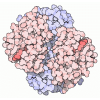
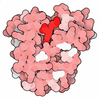
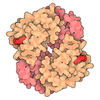
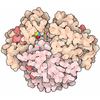
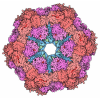


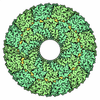

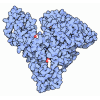


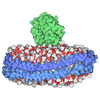


 Z (Sec.)
Z (Sec.) Y (Row.)
Y (Row.) X (Col.)
X (Col.)













































